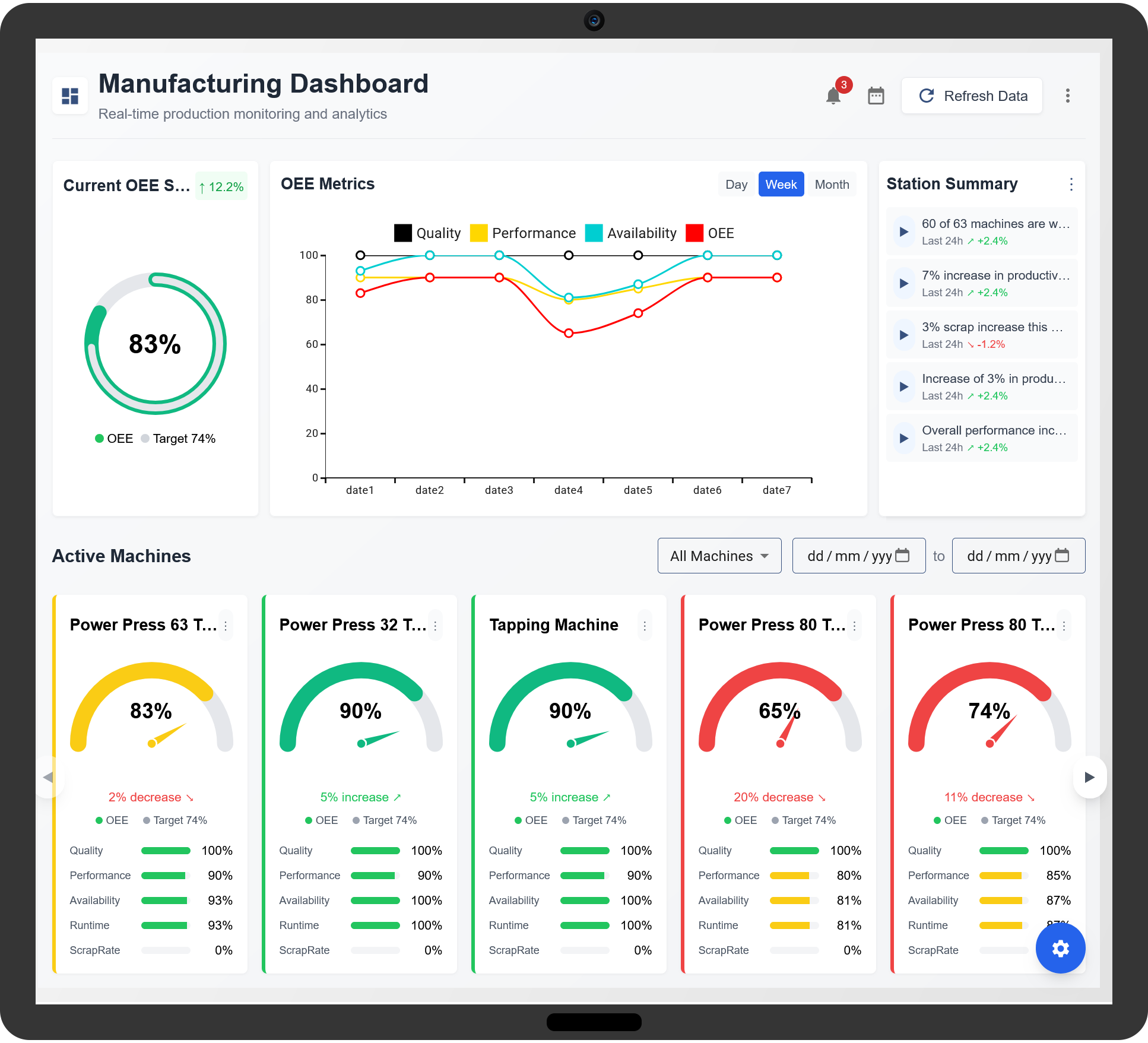Overall Equipment Effectiveness (OEE) monitoring systems are essential for manufacturers aiming to optimize production efficiency and reduce operational losses. By continuously tracking availability, performance, and quality, OEE software helps businesses make data-driven decisions to enhance productivity. Implementing an effective OEE monitoring system requires a strategic approach, and key tips and insights.

1. Understanding OEE Monitoring Systems
OEE monitoring systems provide real-time visibility into manufacturing operations by collecting and analyzing machine data. These systems identify inefficiencies, track downtime, and highlight opportunities for process improvement. The three main factors measured in OEE monitoring include:
- Availability: Measures equipment uptime and highlights the impact of breakdowns and setup changes.
- Performance: Assesses whether machines are running at their optimal speed.
- Quality: Tracks the percentage of defect-free products manufactured.
By continuously monitoring these metrics, manufacturers can enhance productivity and reduce waste.
2. Benefits of OEE Monitoring Systems
- Real-Time Performance Tracking: Provides live insights into machine status and production efficiency.
- Downtime Reduction: Helps identify and address root causes of equipment stoppages.
- Improved Quality Control: Ensures that defects are detected early, minimizing waste.
- Data-Driven Decision-Making: Supports continuous improvement initiatives with detailed analytics.
- Increased Productivity: Optimizes resource utilization and workflow efficiency.
3. How to Optimize OEE Monitoring Systems
Maximizing the benefits of an OEE monitoring system requires a well-structured approach. Below are key steps to optimize OEE tracking and performance improvement.
Step 1: Ensure Accurate Data Collection
Reliable OEE monitoring starts with precise data collection. Automated data capture methods, such as IoT-enabled sensors, reduce human errors and provide real-time updates. It is essential to standardize data input formats and ensure all equipment is properly integrated with the monitoring system.
Step 2: Identify and Address Downtime Causes
Unplanned downtime is one of the biggest contributors to efficiency loss. OEE systems categorize downtime into planned and unplanned stoppages, helping manufacturers prioritize maintenance schedules, streamline setup times, and implement predictive maintenance strategies.
Step 3: Analyze Performance Trends
Tracking performance over time allows businesses to identify recurring bottlenecks. Speed losses, idle times, and slow cycle rates can be minimized by optimizing machine parameters, improving worker training, and refining workflow layouts.
Step 4: Focus on Quality Improvements
Defective products reduce overall OEE scores. Root cause analysis should be conducted to determine why defects occur, whether due to machine issues, material inconsistencies, or human errors. Implementing automated quality checks can further enhance defect detection.
Step 5: Utilize Data-Driven Insights
OEE monitoring systems generate reports and dashboards that highlight efficiency trends. Reviewing these insights regularly allows production managers to implement continuous improvement measures, track the impact of changes, and refine processes for long-term success.
4. Best Practices for Implementing OEE Software
To ensure successful implementation of an OEE monitoring system, manufacturers should consider the following best practices:
- Define Clear Objectives: Establish specific goals for tracking and improving OEE metrics.
- Engage Employees: Train staff on how to interpret OEE data and take corrective actions.
- Automate Data Collection: Minimize manual data entry errors by using automated monitoring tools.
- Integrate with Other Systems: Connect OEE software with ERP and MES solutions for a holistic view of production.
- Regularly Update KPIs: Continuously refine key performance indicators (KPIs) to align with business objectives.
5. Future Trends in OEE Monitoring
OEE monitoring systems are evolving with advancements in artificial intelligence, machine learning, and predictive analytics. The integration of smart manufacturing technologies will further enhance real-time decision-making, predictive maintenance, and overall equipment efficiency. As digital transformation accelerates, businesses adopting these innovations will gain a competitive edge in manufacturing.
By implementing best practices and leveraging cutting-edge technology, manufacturers can maximize the benefits of OEE monitoring systems, ensuring continuous improvement and s
OEE monitoring system
What is an OEE monitoring system?
An OEE monitoring system is a tool that tracks overall equipment effectiveness by measuring availability, performance, and quality in manufacturing operations.
How does an OEE monitoring system work?
It collects data from machines and processes, providing real-time insights to help improve productivity and reduce downtime.
Why is OEE monitoring important for manufacturing?
OEE monitoring identifies inefficiencies, tracks production performance, and supports continuous improvement in manufacturing processes.
What are the key components of an OEE monitoring system?
The key components include real-time data collection, performance tracking, downtime analysis, and reporting dashboards.
How does real-time OEE tracking improve efficiency?
It allows immediate identification of issues, enabling faster response times and reducing production losses.
What metrics can be analyzed with an OEE monitoring system?
Metrics include availability, performance, quality, cycle time, and production throughput.
How does downtime tracking impact OEE performance?
Tracking downtime helps identify recurring issues, optimize maintenance schedules, and reduce unplanned stops.
What are the best practices for implementing an OEE monitoring system?
Best practices include setting clear KPIs, training staff, integrating with existing systems, and regularly analyzing data.
How does an OEE system help identify production bottlenecks?
By analyzing performance and downtime data, an OEE system pinpoints bottlenecks that slow down production.
Can OEE monitoring systems integrate with existing manufacturing software?
Yes, most OEE systems can integrate with ERP, MES, and other production management tools.
How do automated OEE monitoring systems compare to manual tracking?
Automated systems provide accurate, real-time data with less human error compared to manual tracking.
What are common challenges in OEE system implementation?
Challenges include resistance to change, data accuracy issues, and the need for proper staff training.
How can OEE monitoring improve overall equipment maintenance?
It helps schedule predictive maintenance, reducing unexpected breakdowns and improving machine reliability.
What is the role of AI and automation in OEE monitoring?
AI and automation enhance OEE by predicting failures, optimizing workflows, and improving data accuracy.
How frequently should OEE data be reviewed?
OEE data should be reviewed in real time for quick decision-making and at regular intervals for trend analysis.